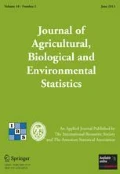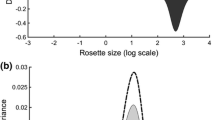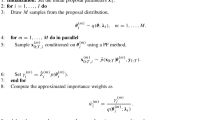Abstract
Population dynamics with regard to evolution of traits has typically been studied using matrix projection models (MPMs). Recently, to work with continuous traits, integral projection models (IPMs) have been proposed. Imitating the path with MPMs, IPMs are handled first with a fitting stage, then with a projection stage. Fitting these models has so far been done only with individual-level transition data. These data are used to estimate the demographic functions (survival, growth, fecundity) that comprise the kernel of the IPM specification. Then, the estimated kernel is iterated from an initial trait distribution to project steady state population behavior under this kernel. When trait distributions are observed over time, such an approach does not align projected distributions with these observed temporal benchmarks.
The contribution here, focusing on size distributions, is to address this issue. Our concern is that the above approach introduces an inherent mismatch in scales. The redistribution kernel in the IPM proposes a mechanistic description of population level redistribution. A kernel of the same functional form, fitted to data at the individual level, would provide a mechanistic model for individual-level processes. Resulting parameter estimates and the associated estimated kernel are at the wrong scale and do not allow population-level interpretation.
Our approach views the observed size distribution at a given time as a point pattern over a bounded interval. We build a three-stage hierarchical model to infer about the dynamic intensities used to explain the observed point patterns. This model is driven by a latent deterministic IPM and we introduce uncertainty by having the operating IPM vary around this deterministic specification. Further uncertainty arises in the realization of the point pattern given the operating IPM. Fitted within a Bayesian framework, such modeling enables full inference about all features of the model. Such dynamic modeling, optimized by fitting to data observed over time, is better suited to projection.
Exact Bayesian model fitting is very computationally challenging; we offer approximate strategies to facilitate computation. We illustrate with simulated data examples as well as well as a set of annual tree growth data from Duke Forest in North Carolina. A further example shows the benefit of our approach, in terms of projection, compared with the foregoing individual level fitting.
Similar content being viewed by others
References
Adler, P. B., Ellner, S. P., and Levine, J. M. (2010), “Coexistence of Perennial Plants: An Embarrassment of Niches,” Ecology Letters, 13, 1019–1029.
Banerjee, S., Carlin, B. P., and Gelfand, A. E. (2004), Hierarchical Modeling and Analysis for Spatial Data, Boca Raton: Chapman & Hall/CRC Press.
Banks, H. T., Kareiva, P. M., and Murphy, K. A. (1987), “Parameter Estimation Techniques for Interaction and Redistribution Models: A Predator-Prey Example,” Oecologia, 74, 356–362.
Banks, H. T., Botsford, L. W., Kappell, F., and Wang, C. (1991), “Estimation of Growth and Survival in Size-Structured Cohort Data—An Application to Larval Striped Bass (Morone Saxatilis),” Journal of Mathematical Biology, 30, 125–150.
Caswell, H. (2001), Matrix Population Models: Construction, Analysis and Interpretation (2nd ed.), Sunderland: Sinauer.
— (2008), “Perturbation Analysis of Nonlinear Matrix Population Models,” Demographic Research, 18, 59–116.
Chakraborty, A., Gelfand, A. E., Wilson, A. M., Latimer, A. M., and Silander, J. A. (2011), “Point Pattern Modeling for Degraded Presence-Only Data Over Large Regions,” Journal of Royal Statistical Society, Series C, 60 (5), 757–776.
Clark, J. S., Bell, D. M., Hersh, M. H., and Nichols, L. (2011a), “Climate Change Vulnerability of Forest Biodiversity: Climate and Resource Tracking of Demographic Rates,” Global Change Biology, 17, 1834–1849.
Clark, J. S., Bell, D. M., Hersh, M. H., Kwit, M., Moran, E., Salk, C., Stine, A., Valle, D., and Zhu, K. (2011b), “Individual-Scale Variation, Species-Scale Differences: Inference Needed to Understand Diversity.” Ecology Letters, 14, 1273–1287
Clark, J. S., Bell, D. M., Dietze, M., Hersh, M., Ibáñez, I., LaDeau, S., McMahon, S., Metcalf, J., Moran, E., Pangle, L., and Wolosin, M. (2010a), “Models for Demography of Plant Populations,” in The Oxford Handbook of Applied Bayesian Analysis, eds. T. O’Hagan and M. West, London: Oxford University Press, pp. 431–481.
Clark, J. S., Bell, D., Chu, C., Courbaud, B., Dietze, M., Hersh, M., HilleRisLambers, J., Ibáñez, I., LaDeau, S., McMahon, S., Metcalf, J., Mohan, J., Moran, E., Pangle, L., Pearson, S., Salk, C., Shen, Z., Valle, D., and Wyckoff, P. (2010b), “High-Dimensional Coexistence Based on Individual Variation: A Synthesis of Evidence,” Ecological Monographs, 80, 569–608.
Dahlgren, J. P., Garcia, M. B., and Ehrlén, J. (2011), “Nonlinear Relationships Between Vital Rates and State Variables in Demographic Models,” Ecology. doi:10.1890/10-1184.1.
Dalgleish, H. J., Koons, D. N., Hooten, M. B., Moffet, C. A., and Adler, P. B. (2011), “Climate Influences the Demography of Three Dominant Sagebrush Steppe Plants,” Ecology, 92, 75–85.
Davis, P. J., and Rabinowitz, P. (1984), Methods of Numerical Integration (2nd ed.), New York: Academic Press.
Dennis, B., Desharnais, R. A., Cushing, J. M., and Costantino, R. F. (1997), “Transitions in Population Dynamics: Equilibria to Periodic Cycles to Aperiodic Cycles,” Journal of Animal Ecology, 66, 704–729.
Dennis, B., Desharnais, R. A., Cushing, J. M., and Costantino, R. F. (1995), “Nonlinear Demographic Dynamics: Mathematical Models, Statistical Methods, and Biological Experiments,” Ecological Monographs, 65, 261–281.
Diggle, P. J. (2003), Statistical Analysis of Spatial Point Patterns (2nd ed.), London: Arnold.
Easterling, M. R., Ellner, S. P., and Dixon, P. M. (2000), “Size-Specific Sensitivity: Applying a New Structured Population Model,” Ecology, 81, 694–708.
Ellner, S. P., and Rees, M. (2006), “Integral Projection Models for Species With Complex Demography,” The American Naturalist, 167, 410–428.
— (2007), “Stochastic Stable Population Growth in Integral Projection Models: Theory and Application,” Journal of Mathematical Biology, 54, 227–256.
Harding, M. C., and Hausman, J. (2007), “Using a Laplace Approximation to Estimate the Random Coefficients Logit Model by Non-linear Least Squares,” International Economic Review, 48, 1311–1328.
Hooten, M. B., Wikle, C. K., Dorazio, R. M., and Royle, J. A. (2007), “Hierarchical Spatio-Temporal Matrix Models for Characterizing Invasions,” Biometrics, 63, 558–567.
Keyfitz, N., and Caswell, H. (2005), Applied Mathematical Demography (3rd ed.), New York: Springer.
Kot, M., Lewis, M., and van den Driessche, P. (1996), “Dispersal Data and the Spread of Invading Organisms,” Ecology, 77, 2027–2042.
Rees, M., and Ellner, S. P. (2009), “Integral Projection Models for Populations in Temporally Varying Environments,” Ecological Monographs, 79, 575–594.
Ricker, W. E. (1954), “Stock and Recruitment,” Journal of the Fisheries Research Board of Canada, 11, 559–623.
Tierney, L., Kass, R. E., and Kadane, J. B. (1989a), “Fully Exponential Laplace Approximations to Expectations and Variances of Nonpositive Functions,” Journal of the American Statistical Association, 84, 710–716.
— (1989b), “Approximate Marginal Densities of Nonlinear Functions,” Biometrika, 76, 425–433.
Tuljapurkar, S. (1990), Population Dynamics in Variable Environments, London: Springer.
Tuljapurkar, S., and Caswell, H. (eds.) (1997), Structured-Population Models in Marine, Terrestrial, and Freshwater Systems, New York: Chapman & Hall.
Wakefield, J. (2009), “Multi-Level Modelling, the Ecologic Fallacy, and Hybrid Study Designs,” International Journal of Epidemiology, 38, 330–336.
Wikle, C. K. (2002), “A Kernel-Based Spectral Model for Non-Gaussian Spatio-Temporal Processes,” Statistical Modelling: An International Journal, 2, 299–314.
Wikle, C. K., and Hooten, M. B. (2010), “A General Science-Based Framework for Nonlinear Spatio-Temporal Dynamical Models,” Test, 19, 417–451.
Xu, K., Wikle, C. K., and Fox, N. (2005), “A Kernel Based Spatio Temporal Dynamical Model for Nowcasting Radar Precipitation,” Journal of the American Statistical Association, 100, 1133–1144.
Zhang, H. (2004), “Inconsistent Estimation and Asymptotically Equal Interpolations in Model-Based Geostatistics,” Journal of the American Statistical Association, 99, 250–261.
Zuidema, P. A., Jongejans, E., Chien, P. D., During, H. J., and Schieving, F. (2010), “Integral Projection Models for Trees: A New Parameterization Method and a Validation of Model Output,” Journal of Ecology, 98, 345–355.
Author information
Authors and Affiliations
Corresponding author
Additional information
This invited paper is discussed in the comments available at doi:10.1007/s13253-012-0119-5, doi:10.1007/s13253-012-0120-z, doi:10.1007/s13253-012-0121-y.
Rights and permissions
About this article
Cite this article
Ghosh, S., Gelfand, A.E. & Clark, J.S. Inference for Size Demography From Point Pattern Data Using Integral Projection Models. JABES 17, 641–677 (2012). https://doi.org/10.1007/s13253-012-0123-9
Published:
Issue Date:
DOI: https://doi.org/10.1007/s13253-012-0123-9




